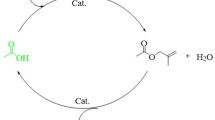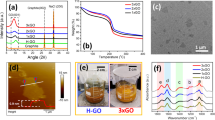Abstract
The ultimate objective is to create strategies for glycol acetalization that are both economically and ecologically benign. The product cyclic dioxolane formed by acetalization of glycol shows excellent solvent properties as it is non-carcinogenic and causes no ozone related problems. It is used as a component of solvent in batteries and also finds application in the fragrance, flavour, pharmaceutical, polymers and textile industries. Herein we report a highly promising and environmentally benign process for converting glycol into 2,2 dimethyl 1,3 dioxolane via acetalization through NiO@B@GCN nanocubes catalys. Comprehensive analysis shows that the high catalytic performance of NiO@B@GCN nanocubes is the result of the cooperation of band gap engineering and efficient charge transfer capabilities. This work demonstrates the use of a synergistic strategy to effectively synthesize soft NiO@B@GCN nanocubes as a promising catalyst that exhibit excellent product yield.
Graphical Abstract









Similar content being viewed by others
References
Ilgen O, Yerlikaya S, Akyurek FO (2017) Synthesis of solketal from glycerol and acetone over amberlyst-46 to produce an oxygenated fuel additive. Period Polytech Chem Eng 61:144–148
Chopade SP, Sharma MM (1997) Acetalization of ethylene glycol with formaldehyde using cation-exchange resins as catalysts: Batch versus reactive distillation. React Funct Polym 34:37–45
Yadav GD, Katole SO (2014) Selective Acetalization of ethylene glycol with methyl 2-napthyl ketone over solid acids: Efficacy of acidic clay supported Cs2.5H0.5PW12O40. Catal Today 237:125–135
Han X, Yan W, Chen K et al (2014) Heteropolyacid-based ionic liquids as effective catalysts for the synthesis of benzaldehyde glycol acetal. Appl Catal A Gen 485:149–156
Gu Y, Azzouzi A, Pouilloux Y et al (2008) Heterogeneously catalyzed etherification of glycerol: new pathways for transformation of glycerol to more valuable chemicals. Green Chem 10:164–167
Melero JA, Vicente G, Morales G et al (2010) Oxygenated compounds derived from glycerol for biodiesel formulation: Influence on EN 14214 quality parameters. Fuel 89:2011–2018
Abdullah Khan M, Teixeira IF, Li MMJ et al (2016) Graphitic carbon nitride catalysed photoacetalization of aldehydes/ketones under ambient conditions. Chem Commun 52:2772–2775
Jermy BR, Pandurangan A (2005) Catalytic application of Al-MCM-41 in the esterification of acetic acid with various alcohols. Appl Catal A Gen 288:25–33
Mallick S, Parida KM (2007) Studies on heteropoly acid supported zirconia II. Liquid phase bromination of phenol and various organic substrates. Catal Commun 8:889–893
Wang S, Guin JA (2000) Silica-supported sulfated zirconia: a new effective acid solid for etherification. Chem Commun 24:2499–2500
Song SH, Park DR, Woo SY et al (2010) Direct preparation of dichloropropanol from glycerol and hydrochloric acid gas using heteropolyacid (HPA) catalyst by heterogeneous gas phase reaction. J Ind Eng Chem 16:662–665
Cho H-J, Kwon H-M, Tharun J, Park D-W (2010) Synthesis of glycerol carbonate from ethylene carbonate and glycerol using immobilized ionic liquid catalysts. J Ind Eng Chem 16:679–683
Behr A, Eilting J, Irawadi K et al (2008) Improved utilisation of renewable resources: New important derivatives of glycerol. Green Chem 10:13–30
Miyazawa T, Kusunoki Y, Kunimori K, Tomishige K (2006) Glycerol conversion in the aqueous solution under hydrogen over Ru/C+ an ion-exchange resin and its reaction mechanism. J Catal 240:213–221
Tsukuda E, Sato S, Takahashi R, Sodesawa T (2007) Production of acrolein from glycerol over silica-supported heteropoly acids. Catal Commun 8:1349–1353
Zhou C-HC, Beltramini JN, Fan Y-X, Lu GQM (2008) Chemoselective catalytic conversion of glycerol as a biorenewable source to valuable commodity chemicals. Chem Soc Rev 37:527–549
He L, Chen L, Nie Y, et al (2024) A practical approach for enhanced biodiesel production using organic modified montmorillonites as efficient heterogeneous hybrid catalysts. Green Chem
De Lima RB, Paganin V, Iwasita T, Vielstich W (2003) On the electrocatalysis of ethylene glycol oxidation. Electrochim Acta 49:85–91
Lele BS, Kulkarni MG (1998) Single step room temperature oxidation of poly (ethylene glycol) to poly (oxyethylene)-dicarboxylic acid. J Appl Polym Sci 70:883–890
Vicente G, Melero JA, Morales G et al (2010) Acetalisation of bio-glycerol with acetone to produce solketal over sulfonic mesostructured silicas. Green Chem 12:899–907
Garcia E, Laca M, Pérez E et al (2008) New class of acetal derived from glycerin as a biodiesel fuel component. Energy Fuels 22:4274–4280
Silva PHR, Gonçalves VLC, Mota CJA (2010) Glycerol acetals as anti-freezing additives for biodiesel. Bioresour Technol 101:6225–6229
Olajire AA, Mohammed AA (2019) Green synthesis of nickel oxide nanoparticles and studies of their photocatalytic activity in degradation of polyethylene films. Adv Powder Technol 31:211–218
Jaysiva G, Manavalan S, Chen SM et al (2020) MoN Nanorod/Sulfur-Doped Graphitic Carbon Nitride for Electrochemical Determination of Chloramphenicol. ACS Sustain Chem Eng 8:11088–11098
Poly SS, Jamil MAR, Touchy AS et al (2019) Acetalization of glycerol with ketones and aldehydes catalyzed by high silica Hβ zeolite. Mol Catal 479:110608
Ozorio LP, Pianzolli R, Mota MBS, Mota CJA (2012) Reactivity of glycerol/acetone ketal (solketal) and glycerol/formaldehyde acetals toward acid-catalyzed hydrolysis. J Braz Chem Soc 23:931–937
Thaweesak S, Wang S, Lyu M et al (2017) Boron-doped graphitic carbon nitride nanosheets for enhanced visible light photocatalytic water splitting. Dalt Trans 46:10714–10720
Liu J, Zhang T, Wang Z et al (2011) Simple pyrolysis of urea into graphitic carbon nitride with recyclable adsorption and photocatalytic activity. J Mater Chem 21:14398–14401
Niu P, Zhang L, Liu G, Cheng H (2012) Graphene-like carbon nitride nanosheets for improved photocatalytic activities. Adv Funct Mater 22:4763–4770
Lu X, Xu K, Chen P et al (2014) Facile one step method realizing scalable production of gC 3 N 4 nanosheets and study of their photocatalytic H 2 evolution activity. J Mater Chem A 2:18924–18928
Ran J, Ma TY, Gao G et al (2015) Porous P-doped graphitic carbon nitride nanosheets for synergistically enhanced visible-light photocatalytic H2 production. Energy Environ Sci 8:3708–3717
She X, Wu J, Zhong J et al (2016) Oxygenated monolayer carbon nitride for excellent photocatalytic hydrogen evolution and external quantum efficiency. Nano Energy 27:138–146
Wang SQ, Zhang XY, Dao XY et al (2020) Cu2O@Cu@UiO-66-NH2ternary nanocubes for photocatalytic CO2reduction. ACS Appl Nano Mater 3:10437–10445
Kocijan A, Donik Č, Jenko M (2007) Electrochemical and XPS studies of the passive film formed on stainless steels in borate buffer and chloride solutions. Corros Sci 49:2083–2098
Bansod AV, Patil AP, Verma J, Shukla S (2019) Microstructure, mechanical and electrochemical evaluation of dissimilar low Ni SS and 304 SS using different filler materials. Mater Res 22:1–14
Hashimoto K, Asami K, Kawashima A et al (2007) The role of corrosion-resistant alloying elements in passivity. Corros Sci 49:42–52
Kumar K, Yadav RK, Verma RK et al (2023) Unleashing the solar revolution: harnessing the power of an ultra-strong tensile strength PGTPP nanocomposite photocatalyst for artificial photosynthesis. Catal Sci Technol 13:5679–5688
Srivastava S, Yadav RK, Singh S et al (2023) Synthesis of highly efficient nitrogen enrich graphene eosin-Y coupled photocatalyst that uses solar energy in trifluoromethylation of benzaldehydes. J Chem Sci 135:109
Acknowledgements
We express gratitude to the Madan Mohan Malaviya University of Technology, Gorakhpur for financial assistance and CatLab of Indian Institute of Science, Bangalore for characterization and their complete investigation.
Author information
Authors and Affiliations
Corresponding authors
Additional information
Publisher's Note
Springer Nature remains neutral with regard to jurisdictional claims in published maps and institutional affiliations.
Rights and permissions
Springer Nature or its licensor (e.g. a society or other partner) holds exclusive rights to this article under a publishing agreement with the author(s) or other rightsholder(s); author self-archiving of the accepted manuscript version of this article is solely governed by the terms of such publishing agreement and applicable law.
About this article
Cite this article
Dubey, N., Yadav, R.K., Mishra, S. et al. Aerobic Acetalization of Ethylene Glycol with Acetone by Newly Designed Highly Efficient Soft NiO@B@GCN Nanocubes Catalyst. Catal Lett (2024). https://doi.org/10.1007/s10562-024-04694-y
Received:
Accepted:
Published:
DOI: https://doi.org/10.1007/s10562-024-04694-y




